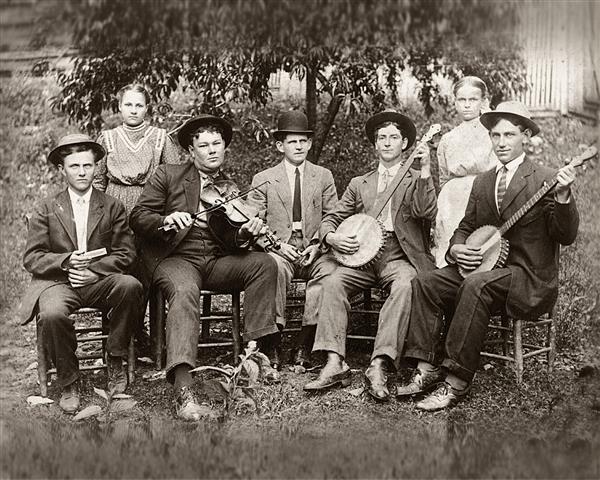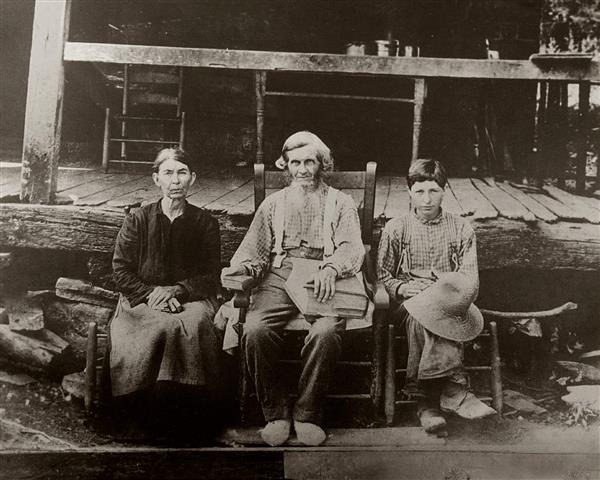
The Chicken Band, one of many Southern string bands of the hoedown era, was known for their habit of eating fried chicken after their shows
Out of the soft gray clouds looming above the sweltering August mist, a single ray beamed into the tall pines as a lone wanderer trudged silently through the piney woods. Step by step, the soft trudging formed deep tracks into the untraveled road. While a wild, hot swirling wind surged through the hill traces, a solitary figure with a broad-brimmed hat and brown, woolen cloak became visible. Scarred by years of resentment and troubled by disappointment, the shrouded figure slogged clumsily, crunching the terrain beneath. Barely subsisting under his sagging cabin, there had been years of isolation, a self-imposed exile of loneliness and hopelessness in this remote area of Tennessee near Nashville.
With his fiddle by his side, he pressed forward through the hills on the newly paved road to the city. The old tunes, like wistful memories of past lovers, were imbedded in his mind and soul. The frustrated wayfarer muttered, “If I could just get to Nashville, things and life would get better.” As the sun began to light the way, slowly illuminating the moss-covered ground, a cry, an intoning implored from a determined voice within. “Gotta get out of this holler and down to the flatlands at the Cumberland!”
The indomitable soul was ready to get beyond the emotional imprisonment of the past—no more excuses, no more distorted realities and no more unrealistic methods of coping. Life on Paradise Ridge had kept him trapped in simple survival, but now he had made the decision to leave his lifestyle near the ravine on the limestone knob. Bringing his folk culture, the old stories and the singing of old songs, he was focused on finding work. He would share his music, creating a better life in Nashville.
In 1925, an entertainer’s connection to the Opry in those early days meant a long drive by car, wagon or buggy to Nashville, not through the spectacular mountains of the Smokies, but through the countryside of the hills of Middle Tennessee, some of the most rugged terrain in the state. For many of those early entertainers, the trip meant leaving by car early Saturday, getting to Nashville before noon, unloading, tuning their instruments and performing on WSM 650 AM, followed by the long drive home in the wee hours of the morning. Although the connection was difficult, the early Opry was assured a pipeline to the rural folk culture that it claimed to celebrate. It was this connection and setting that thrived in those early days with artists like Dr. Humphrey Bate from Gallatin, Sid Harkreader and Jack Jackson from Lebanon, Kirk and Sam McGee from Franklin, Uncle Jimmy Thompson from LaGuardo, and our own Uncle Dave Macon from Murfreesboro.
Radio had come to Nashville rather late in the game. By 1925, radio stations had already been broadcasting for three years from Memphis, Atlanta and Dallas. The tiny rural community of Lawrenceburg, some 80 miles south of Nashville near the Alabama line, was broadcasting gospel music on WOAN. Since 1923, the station was owned by the largest publisher of old-time shape-note gospel songs, James D. Vaughn. It boasted having the first radio license in Tennessee. Vaughn sold his equipment to Fred “Pop” Exum and L.N. Smith, which allowed the opportunity to upgrade the equipment and boost the signal from 150 watts to 500 watts from a radio supply store in Nashville. By September of 1925, Nashville’s first radio station was broadcasting. Within two weeks, the broadcast reach was impressive, claiming to transmit 2,000 miles away. The proof came in the form of mail from listeners in New York, Philadelphia, Des Moines, Atlanta, and Dayton, Ohio about the station’s musical programming. But soon the station would have competition when WSM went on the air on October 5, 1925. On Nov. 28 of that same year, the Opry (initially called the WSM Barn Dance) was born with the airing of its famous fiddle performance by Uncle Jimmy Thompson on WSM. It was not long after that the station dominated the market with other old-time musical performances.
The key factor was the development of the hoedown bands in the beginning of the Saturday night barn dance show. George D. Hay was the program director and the decision maker who started the barn dance. Hay became the Opry’s founder. Hay’s vision of himself as a preserver of American folk culture did not fully emerge until the Opry had been established much later as an institution.
The rural areas surrounding Nashville provided the context for those early broadcasts at the birth of the Opry. The broadcasts of the Opry were steeped in the rural traditions of the South and the old-time tunes with which listeners were familiar. As WSM’s executives began to perceive the dimension and tastes of the audience, old-time music became the basis for the early success of the Opry. Proving that the programming was on target, switchboards lit up and letters came pouring in from surrounding cities, all of which became the barometer indicating that their clientele preferred banjo and fiddle music—the old tunes that had been played and sung for years.

A Middle Tennessee cabin family at the turn of the 20th century.
Photos from the historical archives at Shacklett’s Photography
What exactly is a hoedown? The actual word “hoedown” has American roots. Specifically originating from the Southern tradition, it is generally believed that the word is a literal derivative of putting a “hoe down.” Easily, we can romanticize visions of the early American farming communities in the days of agricultural lore. We can well imagine the farmers putting away their spades, scythes and hoes at the end of every long working day in the fields. Perhaps, we are then left to wonder if on certain evenings, these versatile farmers would replace their farming implements with musical instruments. These special nights would become their regular recreational times—with impromptu dancing being creatively performed by musicians and non-musicians—for the whole family.
Haymaking in those bygone times could have followed into merrymaking on certain evenings. These could then have become referred to as their “hoedowns.” A hoedown has certainly come to represent American old-time music of a certain genre coupled with buck dancing and clogging. What is definitely accurate is that the main hoedown and barn dance scene became extremely popular. Their popularity spread through the country into modern interpretations of country and western music.
The hoedown bands on the Grand Ole Opry continued to be a tradition through the 1940s. They became window dressing for the Opry, forming, as Hay would put it, “the backbone, and it would lend a rural flavor to the entire Grand Ole Opry.” He was always careful to schedule the bands in regular intervals throughout the show just in case the other acts became “too uptown or too western.” As Hay would say, the classic old-time tunes played by the old hoedown bands like the Fruit Jar Drinkers, the Crook Brothers, the Gully Jumpers and the Possum Hunters, and Uncle Dave Macon would “get us back to earth the minute they plunk the first note.”
Throughout the early years, the hoedown band was a paragon of continuity, weathering various fads and innovations of country music that swept across the Opry stage. Their wonderful archaic string-band style, with uncompromising zeal and drive, became the standard for the Opry.
Somehow once again, we yearn for some of that authentic, uncontaminated and unspoiled old-time music of those days. These tunes bring us back to an uninhibited, joyous expression that is contagious, smoothing over our fear and anxiety. In our day, we are craving this musical expression. Not only is it filled with fun and frolic, but it is healthy and healing to the soul. The endearing quality of the content and musical expression of those old tunes has an effect that is indescribable. An evening of hoedown music is not usually an acquired taste; the taste is usually acquired immediately. Having said that, for the 2016 Uncle Dave Macon Days, plans are being made to celebrate this era with the “World’s Largest Square Dance Hoedown!” Don’t miss this event. Mark your calendar for the second week in July, 2016. We plan on celebrating the sharing of this hoedown music with the world right here in Murfreesboro. A glimpse of this happened Saturday night in 2015, when the entire, thousands-strong crowd at Uncle Dave Macon Days erupted in dancing and singing with The Hogslop String Band.














[…] More @ boropulse.com […]
Pingback April 12, 2022 @ 2:01 am